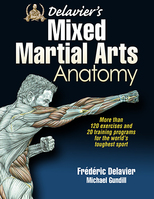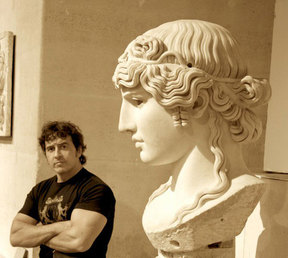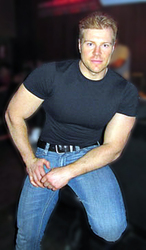|
Press
|
|

Delavier's Mixed Martial Arts Anatomy
|

By Frédéric Delavier and Michael Gundill
ISBN: 978-1-4504-6359-1
Binding: Paperback
Pages: 144
Illustrations: 357 full-color
Price: $24.95
Available: November 2013
Best-selling author Frédéric Delavier outlines the importance of focusing on those physical qualities required in a mixed martial arts fight
Most MMA fighters understand that the strength they gain from training in a gym will translate into improved performance in the ring. But according to best-selling author Frédéric Delavier, the more experienced someone is as a fighter, the more problematic this transfer becomes. To ensure an optimal transfer, he says a fighter’s strength training needs to target those physical qualities actually required in a fight.
In his forthcoming new book, Delavier’s Mixed Martial Arts Anatomy, the French powerlifting champion details why it’s imperative for fighters to adhere to these eight principles as faithfully as possible:
- Fight conditions. Many of the most popular strength training exercises, such as the wide-grip bench press, do not correspond well to the strikes used in a fight. Delavier points out that while this exercise will prove beneficial to a beginner who is not very strong, it is not well suited for an experienced fighter because it is rare to throw a punch while the shoulder blades are stabilized on a bench or on the floor. To optimize fighting ability while standing, fighters should do strength training exercises while standing up and without supporting the shoulder blades.
- Direction of movement. Delavier warns that beginners wanting to do bench presses need to avoid the common mistake of using a wide grip as in classic strength training. “A wide grip does not correlate with the kinds of strikes used during fights, since you rarely hit on the outside of the body,” he says. Instead, fighters should use a narrow grip more in line with the width of their strikes.
- Direction of strength. When throwing a punch, fighters have to overcome horizontal resistance, which is why Delavier believes it would not be useful to box with dumbbells, since they provide vertical resistance. He recommends using something more appropriate, like a cable machine or an elastic band that is parallel to the floor.
- The sides of the body used in the fight. Since fighters do not punch with both fists at the same time, it is better to do bench presses with only one arm at a time. However, Delavier notes, once an opponent is knocked down, a fighter does use both arms together, which closely matches the action of a deadlift. “Choking an opponent to the ground with your thighs is always a bilateral movement,” he explains. “Therefore, you should choose strength training exercises on a case-by-case basis depending on which sides of the body are used in the exercise.”
- Range of motion in movements. Strength training exercises should mirror the range of motion used in fighting moves. Delavier stresses that it is not helpful to do exercises with a greater range of motion but rather with a slightly smaller range of motion because it will help a fighter get stronger without constituting the majority of the workout.
- Types of muscle contraction necessary in a fight. Classic strength training exercises, for the most part, have a back-and-forth rhythm of contraction. While this harmonious succession correlates perfectly with something like running sports, during a fight the series of moves happen with much less certainty, often with a few seconds of rest between blows. Delavier says fighters need to practice this style of random movement.
- Speed of execution. “How quickly you move your weights while you are strength training should match what you do in a fight,” Delavier comments. He suggests using many different speeds during workouts: “Explosive so you can throw a punch, using a little more strength when you want to knock an opponent down or flip him over, and isometric—with almost no movement—for many holds done on the ground, such as locks, chokes, and defensive moves.”
- Types of strength required in a fight. Strength is a generic term that encompasses many realities. Delavier thinks it is a good idea for fighters to analyze the primary movements in a fight so that they can define which muscle qualities they need to develop first.
In Delavier’s Mixed Martial Arts Anatomy, Delavier and co-author Michael Gundill provide more than 120 exercises and 20 training programs for MMA fighters of all levels of experience. Featuring the most effective exercises for enhancing the full range of combat skills, this invaluable resource is packed with 237 full-color photos and 120 of the stunning anatomical illustrations for which Delavier is famous, having now sold millions of strength training books worldwide.

|

|
|
Frédéric Delavier is a gifted artist with an exceptional knowledge of human anatomy. He studied morphology and anatomy for five years at the prestigious École des Beaux-Arts in Paris and studied dissection for three years at the Paris Faculté de Médecine. The former editor in chief of the French magazine PowerMag, Delavier is currently a journalist for the French magazine Le Monde du Muscle and a contributor to several other muscle publications, including Men’s Health Germany. He is the author of the best-selling Strength Training Anatomy, Women’s Strength Training Anatomy, The Strength Training Anatomy Workout, Delavier’s Core Training Anatomy, and Delavier’s Stretching Anatomy. Delavier lives in Paris, France.
Delavier won the French powerlifting title in 1988 and makes annual presentations on the sport applications of biomechanics at conferences in Switzerland. His teaching efforts have earned him the Grand Prix de Techniques et de Pédagogie Sportive. Delavier lives in Paris, France.
Michael Gundill has written 13 books on strength training, sport nutrition, and health, including coauthoring The Strength Training Anatomy Workout and The Strength Training Anatomy Workout II. His books have been translated into multiple languages, and he has written over 500 articles for bodybuilding and fitness magazines worldwide, including Iron Man and Dirty Dieting. Gundill started weightlifting in 1983 in order to improve his rowing performance. Since 1995 he has been writing about his discoveries in various bodybuilding and fitness magazines worldwide. Gundill lives in Saint-Mandé, France.
Part 1
Principles of Strength Training
Developing Your Program
Techniques for Strength and Power
Conditioning and Endurance Techniques
Techniques for Increasing Flexibility
Techniques for Recovery and Injury Prevention
Part 2
Strength Training Exercises Specifically for Fighting
Neck, Trapezius, and Jaw
Strengthening the Abdominal Wall
Punches and Elbow Strikes
Kicks and Knee Strikes
Grabbing, Pulling, and Choking an Opponent
Chokes or Countering a Choke
Lifting and Pulling an Opponent
Part 3
Training Programs
Beginning Programs for Overall Strength
Specialized Programs
Customized Programs
Conditioning Circuits
Customized Circuits
Specialized Circuits You Can Do at Home
Circuits for Injury Prevention

|
 Frédéric Delavier |

 Michael Gundill |

|
- Strength training has become indispensable for mixed martial arts because it improves a fighter’s effectiveness in five ways: it makes strikes more powerful, it develops endurance and resistance, it increases the range of motion in movements (kicks, for example), it creates a protective armor that reduces vulnerability in a fight, and it prevents overuse injuries (the repetitive nature of violent strikes can cause premature damage to muscles and joints; strength training helps prevent this trauma so that a fighter can avoid unnecessary injuries).
- An infinite number of accessories and gadgets are available for strength training and martial arts. If we ignore what is fashionable at the moment, we see that most of these tools are far from necessary. In reality, a weight bar and dumbbells are more than sufficient for excellent strength training.
- In the past, fighting techniques taught as part of a discipline had very little chance of being appropriate for an individual’s morphology (body type). The major revolution in free fighting is that you can select the techniques that are best suited to your own morphology.
- To improve your punches as a beginner, you do not need to work the thighs as much as a champion does. In this way, you can avoid wasting time on your legs when you should focus on the arms and torso rotation. Physical preparation should adapt to the fighting style, not the other way around.
- The better you become as a fighter, the more the force of your punch will come from your thighs, which suggests that the importance given to various muscles will change as you progress. You will have to modify your strength training program over time.
- A workout for muscle mass or strength should ideally last for 45 minutes to one hour. If you manage to spend more than one hour working out, it probably means you were not working out with enough intensity. After one hour, your muscles should be begging for mercy.
- Integrating a strength training program into your fighting training is a critical point, especially when you are first beginning with weights. Adding excess work to your fighting training will increase your body’s need for recovery time and could, at first, cause fatigue. So it is important not to just start doing strength training whenever you feel like it.
- Periodization is a concept that applies to competitive fighters. It comes from the realization that physical preparation must vary in conjunction with competition dates. Since a sport’s season rarely lasts all year, a fighter must perform the best during the competition season. The rest of the time (periods of noncompetition) can be spent on fundamentals or recovery.
- You must reach a critical level of strength that will allow you to contain an opponent, especially if you have not mastered many techniques. It is better for you to give your opponent the impression that he is about to face a steamroller than to feel as if your opponent is the steamroller. The weights you lift in strength training should be heavier than what you encounter in a fight.
- The power of your blows depends on the rate of force development (RFD), or how quickly strength propagates through the muscle. Good RFD allows for rapid diffusion of strength through the muscles.
- For beginners, 14 weeks of strength training using heavy weights that allow for 3 to 10 repetitions accelerates RFD.
- Scientific research shows that working exclusively with heavy weights ends up decreasing the speed of a fighter’s strikes after 12 to 18 weeks. This is why you should not depend solely on heavy training to achieve progress.
- To reduce the degree to which strength training causes neuromuscular disturbance in your strikes, it is a good idea to end your workouts by spending a few minutes hitting a punching bag.
- The difference between experienced fighters and beginners is the speed of muscle relaxation, which is eight times faster in champion fighters. For an inexperienced fighter, the speed of muscle relaxation is too slow for the leg or the fist to gain enough speed when striking a blow. Keeping the antagonistic muscles contracted automatically slows down the movement.
- Plyometric training helps you accelerate the speed of muscle relaxation after a powerful contraction. However, heavy work is still very appropriate for improving a short strike during which there is no relaxation phase.
- Fighters who spend eight weeks working on punches using elastic bands as resistance accelerate the speed of the punch by 17%. However, elastic bands do inhibit the intermediate relaxation sequence, which means that you should not train exclusively with bands. Otherwise you could interfere with the motor learning for your strikes.
- For combat sports that take place partly or completely on the ground or against a cage, static muscular endurance (also called isometric strength) is essential. Isometric means a muscle contraction that combines strength and endurance. If your sport includes this, then you absolutely have to focus on it in your training.
Source: Delavier’s Mixed Martial Arts Anatomy (Human Kinetics, 2013)

|
|
|
|
|

|
 
|